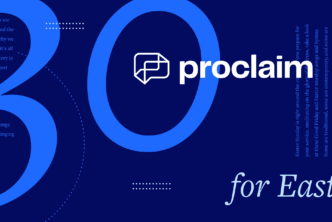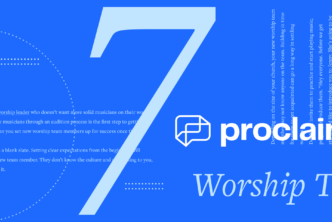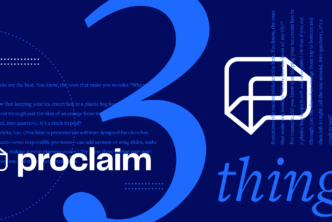No more than 10 slides.
No longer than 20 minutes.
No less than 30 point font.
That’s the 10/20/30 rule as popularized by venture capitalist and entrepreneur Guy Kawasaki, a man who has sat through more than his fair share of presentations. While we probably can’t take his advice as a fixed rule (when was the last time you only preached for 20 minutes on a Sunday morning?) we can definitely learn from the spirit behind it. Let’s break it down.
10 slides
1 slide = 1 idea. Throw too many ideas at your audience, and you run the risk of burying them in trivia. A message overstuffed with truth is like overeating vegetables. It isn’t bad for you per se, but it may diminish the likelihood that you’ll come back to that table again later. With each slide ask yourself: does this visual reinforce my point? That is the point of using visuals after all—to support and reinforce your point.
Do not use your slides as your notes. Use your notes as your notes.
Do not use your slides as your handout. Use your handout as your handout.
I’ve always gotten positive feedback from the messages in which I put content in the slides that I didn’t speak aloud. I almost use the slides as color commentary in the way that some late night hosts have made use of the photo box over their shoulder. Doing this requires a little more effort, but creates a much better experience for the audience.
20 minutes
Google the term “attention span” and you’ll find yourself peering down the veritable rabbit hole filled with both scientific study and speculation. Two things seem to have consensus:
- Our attention spans are shorter than they used to be, and
- They’re getting shorter.
The best preachers don’t assume they are owed the attention of their audience; they work to earn it and they work to keep it. No matter how long you plan to be on the platform, ensure that you aren’t asking your audience to do something they’re physically incapable of—fixing their undivided attention on a single subject for a long time without a chance to break or mentally reset. Illustration, object lessons, jokes, visuals, and the like are useful if only as a way to give the audience a chance to mentally transition from point to point.
30-point font
If you cram every word of your message onto your slides, you haven’t written a sermon. You’ve written a book in Proclaim. For the same reason I recommend including information in your slides that isn’t in your spoken presentation, do the converse as well—include spoken content that doesn’t exist on your slides. Give your audience a reason to lean in and consider every word. Pruning your slides back to the absolute minimum amount of text means you can increase the font size (Proclaim makes this really easy) so even the back row doesn’t have to squint. Kawasaki suggests this algorithm: find out the age of the oldest person in your audience and divide it by two. That’s your optimal font size.
***
Proclaim makes following the 10/20/30 a cinch. Insert Bible verses or song lyrics into a slide in just a few seconds. Proclaim’s user-friendly interface and intuitive design makes it faster and easier than ever to build presentations. Spend minutes—rather than hours or even days—creating state-of-the art, high-quality presentations that will engage your church.





